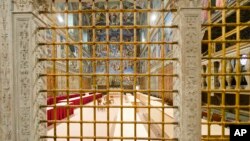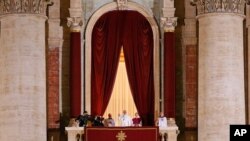When the Roman Catholic Church elects a new pope, it follows a practice that has remained virtually unchanged for centuries. The only difference this time is that the previous pope, Benedict XVI, is still alive.
The voting process of the conclave, as it is called, is shrouded in secrecy. The world will learn the outcome, but only insiders will know what happened.
The time, 115 members of the Church's College of Cardinals will gather in the Sistine Chapel in Vatican City, and do not emerge from their seclusion until they have chosen a new pope. On the first afternoon, one vote is taken. After that, they take four votes each day - two in the morning and two in the afternoon. A successful candidate needs two-thirds of the votes cast.
It took just four ballots to elect Benedict pope in 2005 to replace Pope John Paul II. But more often than not, the balloting takes several days.
No one campaigns openly to become pope. Instead, cardinals gather in small groups to talk to each other and discuss issues of concern to them in their regions of the world.
There is no time limit on a conclave. However long it takes the cardinals to decide, they are locked inside the Vatican, with no newspapers, no television or radio, and no Internet. They all take a vow of secrecy, and their aides also are prohibited from disclosing what takes place. After the morning and afternoon sessions, the ballots are treated with special chemicals and burned in a stove to produce either black or white smoke. Black smoke signifies the vote was not conclusive. White smoke means a new pope has been elected.
When that happens, it normally brings cheers from the thousands of people gathered outside to await the announcement. A senior cardinal then will step onto the balcony of St. Peter's Basilica and declare with great joy that the Church has a new pope.
The newly elected pope remains head of the Church for life, or until he retires, as Benedict did. The pope's reign is referred to as a pontificate.
There were nine different popes in the 20th century. The new pope will be the third in this 21st century.
The voting process of the conclave, as it is called, is shrouded in secrecy. The world will learn the outcome, but only insiders will know what happened.
The time, 115 members of the Church's College of Cardinals will gather in the Sistine Chapel in Vatican City, and do not emerge from their seclusion until they have chosen a new pope. On the first afternoon, one vote is taken. After that, they take four votes each day - two in the morning and two in the afternoon. A successful candidate needs two-thirds of the votes cast.
It took just four ballots to elect Benedict pope in 2005 to replace Pope John Paul II. But more often than not, the balloting takes several days.
No one campaigns openly to become pope. Instead, cardinals gather in small groups to talk to each other and discuss issues of concern to them in their regions of the world.
There is no time limit on a conclave. However long it takes the cardinals to decide, they are locked inside the Vatican, with no newspapers, no television or radio, and no Internet. They all take a vow of secrecy, and their aides also are prohibited from disclosing what takes place. After the morning and afternoon sessions, the ballots are treated with special chemicals and burned in a stove to produce either black or white smoke. Black smoke signifies the vote was not conclusive. White smoke means a new pope has been elected.
When that happens, it normally brings cheers from the thousands of people gathered outside to await the announcement. A senior cardinal then will step onto the balcony of St. Peter's Basilica and declare with great joy that the Church has a new pope.
The newly elected pope remains head of the Church for life, or until he retires, as Benedict did. The pope's reign is referred to as a pontificate.
There were nine different popes in the 20th century. The new pope will be the third in this 21st century.






